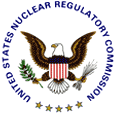 |
NRC NEWS
U. S. NUCLEAR REGULATORY COMMISSION
OFFICE OF PUBLIC AFFAIRS, REGION IV
611 Ryan Plaza Drive - Suite 400
Arlington, Texas 76011-8064 |
| CONTACT: |
Breck Henderson (817) 860-8128 |
RIV: 96-58 FOR IMMEDIATE RELEASE
CONTACT: Breck Henderson November 1, 1996
OFFICE: 817/860-8128
PAGER: (800) 443-7243 (065477)
E-MAIL: bwh@nrc.gov
NRC PROPOSES $13,000 FINE AGAINST CTI ALASKA, INC.
FOR RADIATION WORKER EXPOSURE INCIDENT
The Nuclear Regulatory Commission has proposed a $13,000 fine against CTI Alaska,
Inc., of Anchorage, for an incident in which a worker was exposed to excess radiation after a
radiographic camera malfunctioned. The worker did not receive more than his allowed maximum
annual dose of 5 rem.
The incident took place at Endicott Island, North Slope, during the night shift on
December 23-24, 1995. After using a radiographic camera, workers did not realize that the
radiation source failed to fully retract into its shielded container when a safety latch inside the
locking mechanism prematurely engaged. A radiographic camera is used in industrial
applications, much like an X-ray machine is used in medicine, to detect flaws in dense metal
objects.
The worker, called a radiographer, is trained in the use of the camera and in proper
handling of radiation sources. In this case, the radiographer did not perform an adequate
radiation survey as required at the completion of the job, which would have detected the
unshielded radiation source. He also failed to assure he was wearing a functioning alarm
ratemeter, a safety device that would have warned him he was working in a radiation field. Both
failures are violations of NRC regulations.
When the radiographer made a second check of his radiation survey instrument and looked
at his pocket dosimeter, a second personal radiation monitoring device he is required to carry, he
realized he had been working in a high radiation field. However, he then failed to contact his
supervisor immediately. When contacted, the supervisor failed to immediately contact the
company's radiation safety officer, and the company did not promptly process the radiographer's
film badge, a third personal radiation monitoring device that would indicate the exact dose he
received. These actions are required by NRC-mandated safety procedures and represent
violations.
NRC Regional Administrator Joe Callan said, in a letter to CTI president George E.
Haugen, "[The first two violations] are significant because they represent two breached safety
barriers that are designed to prevent overexposures to radiographers and the public. [The third
and fourth violations] are also significant because they resulted in a delay in CTI's notifications
and response to the incident. . . Therefore, these violations are classified in the aggregate . . . as a
Severity Level II problem." The NRC rates incidents on a four-level scale, with Level I being
the most severe.
Mr. Callan noted in the letter that CTI has taken extensive corrective actions which
include disciplining the radiographers involved, improved emphasis on reporting of incidents,
posting safety memos regarding the incident, increased frequency of safety audits, additional
training on proper use of the radiography camera, and assignment of a new safety coordinator.
CTI must respond to the Notice of Violation in writing within 30 days. The response
must document specific actions taken to prevent recurrence of the incident. During this time the
Company may pay the fine or file a protest.
####
|
